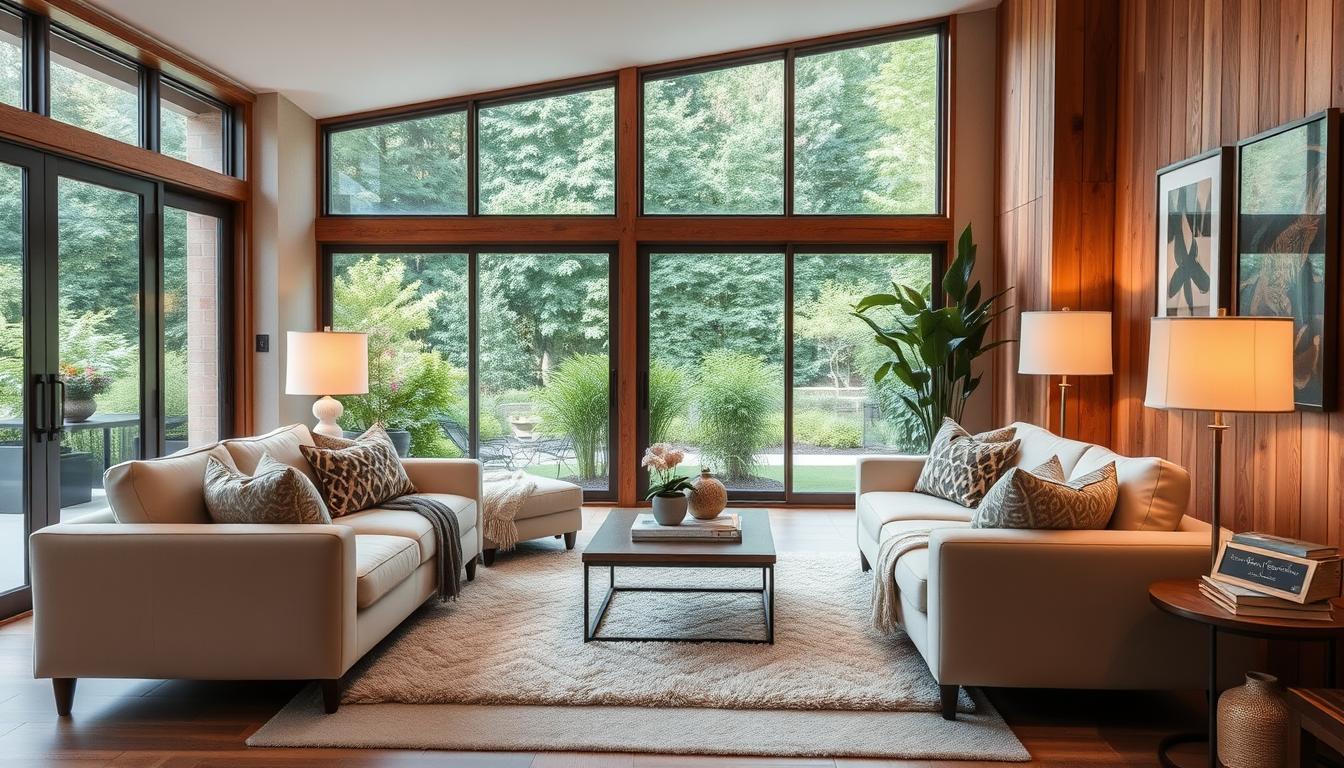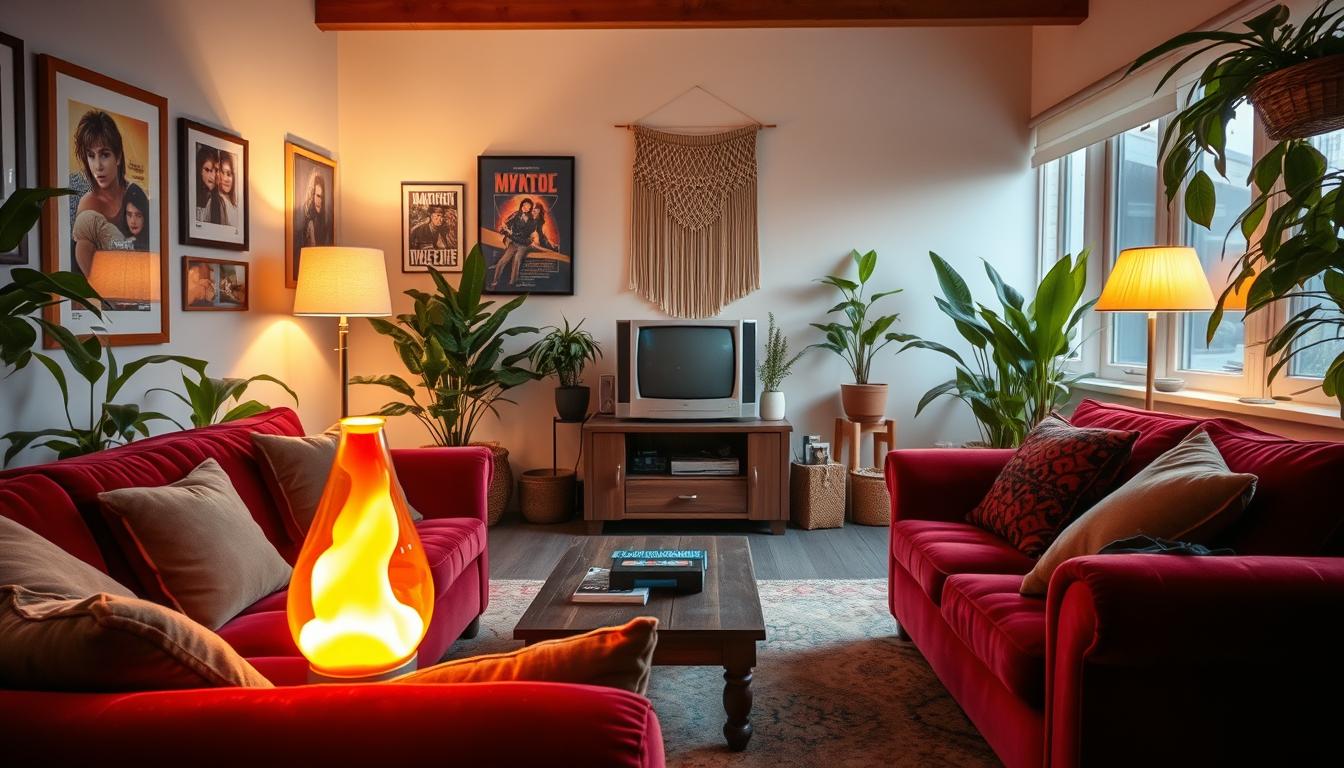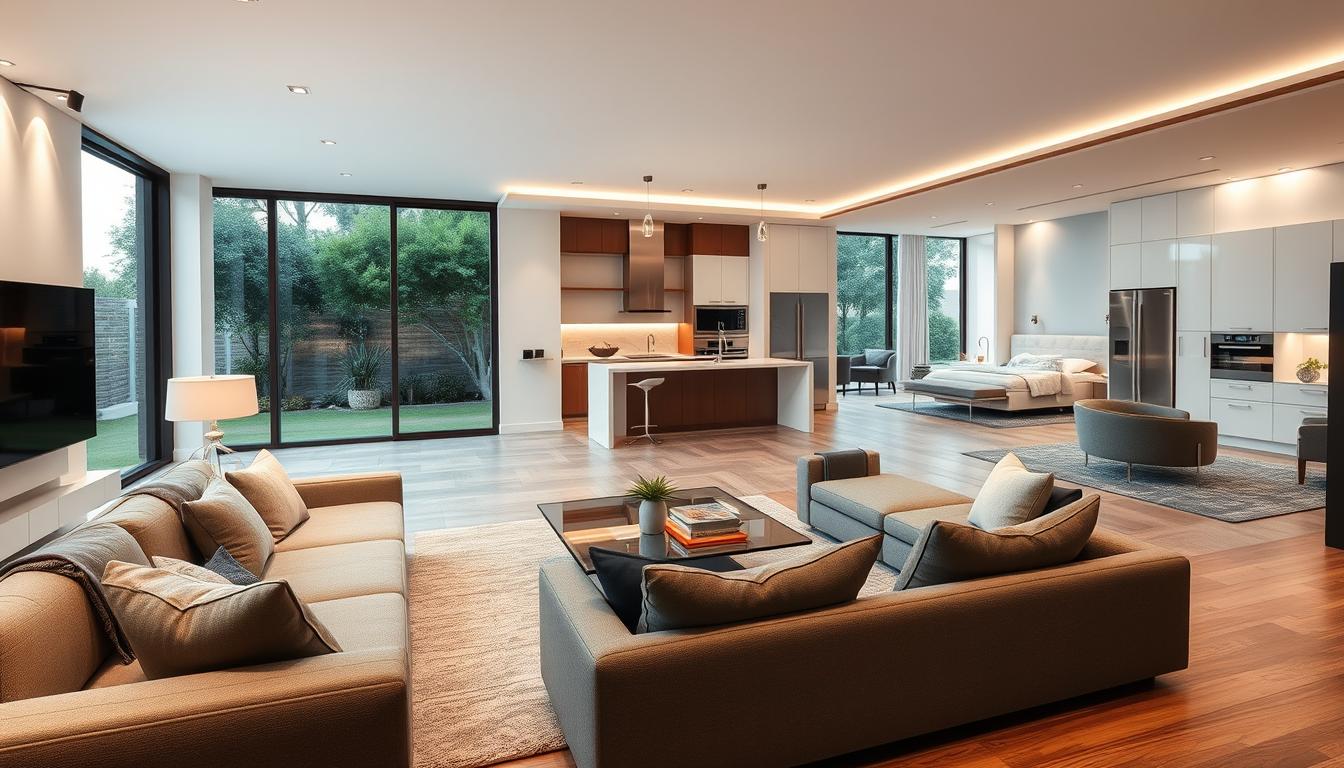Did you know a well-designed living space can make you happier and more productive? Turning your home into a cozy space that shows off your style is easier than you think. With the right home decor inspiration, you can make a space that’s both beautiful and useful.
We’re excited to share our top home and interior design ideas to help you start. We’ll cover everything from minimalism to smart technology. You’ll find lots of design concepts and tips to inspire you.
Key Takeaways
- Discover the latest trends in home decor inspiration
- Learn how to create a functional and beautiful living space
- Explore different design concepts to suit your personal style
- Get tips on incorporating smart technology into your home
- Find out how to make the most of your space with minimalism
1. Embracing Minimalism in Home Design
Minimalism makes your home a calm, clutter-free space. It turns your home into a place of relaxation. This design choice makes your space look good and work well.
Minimalism is not just about getting rid of stuff. It’s about choosing simplicity and clean lines. It uses simple colors and furniture that does more than one thing.
Understanding the Minimalist Aesthetic
The minimalist look believes that less is more. It aims to make your space feel open and calm. To get this look, think about these things:
- Simple color schemes that promote calmness
- Functional furniture with clean lines
- Minimal decor that adds to the serenity of the space
Adding these elements to your home makes it a peaceful place. It’s a place to escape the daily stress.
Tips for Decluttering Your Space
Decluttering is key to minimalism. Here are some tips to help you declutter:
- Start small: Begin with one area or room at a time to avoid feeling overwhelmed.
- Sort items into categories: Decide what to keep, what to donate, and what to discard.
- Focus on functionality: Keep only items that serve a purpose or bring joy.
By following these tips, you can make your home more organized and clutter-free. It will show off the minimalist look.
Embracing minimalism is a journey. It takes patience and dedication. But, the end result is a home that is both beautiful and peaceful.
2. The Importance of Natural Light
Natural light is key in home design. It affects both how a room looks and works. It makes your space look better and is good for your health, helping with sleep and mood.
To get more natural light, make sure windows are clear. Keep them clean and avoid heavy drapes that block the sun. Choosing the right window treatments is important. They help with light, privacy, and protection from UV rays.
Choosing the Right Window Treatments
There are many window treatment options. Sheer curtains let in light while keeping things private. For big windows or sliding doors, roller shades or solar screens are good. They let you control how much light comes in.
| Window Treatment | Benefits | Best For |
|---|---|---|
| Sheer Curtains | Allows natural light, maintains privacy | Bedrooms, Living Rooms |
| Roller Shades | Adjustable light control, sleek design | Large Windows, Sliding Glass Doors |
| Solar Screens | UV protection, energy efficiency | South-Facing Windows, Sunrooms |
Incorporating Mirrors for Reflection
Mirrors can also boost natural light in your home. They reflect sunlight, making rooms brighter and bigger. Place mirrors where they can reflect light from windows.
Think about how your stylish interior design concepts will work with more light. Using mirrors and good window treatments can make your home brighter and more welcoming. It will show off your creative home renovation ideas.
3. Color Psychology in Interior Design
In interior design, picking colors is more than just looks. It’s about feeling and psychology too. The colors we pick can really change how we feel, our energy, and our happiness.
Selecting the Ideal Color Palette
Choosing the right colors for your home takes thought. You need to think about the light, furniture, and what each room is for. For example, soft colors like blues and greens are great for bedrooms. But, bright colors like oranges and yellows can make kitchens and living rooms lively.
- Think about the room’s purpose and the mood you want to create.
- Consider the natural light and how it changes the color.
- Try out colors with a paint swatch before deciding.
By picking the right colors, you can make your home look better and feel welcoming. This is a smart budget-friendly home improvement idea that can really change things without costing a lot.
How Colors Affect Mood and Perception
Different colors can make us feel different ways. For instance, reds and oranges can make us hungry and talkative, perfect for dining rooms. But, cool colors like blues and purples can calm us down, great for relaxing areas.
“The right color can transform a room, making it feel more spacious, cozy, or inviting.” – Interior Design Expert
Knowing how colors affect us can help you choose better for your home. By using color psychology, you can make a space that’s not just pretty but also good for your mind and feelings.
4. Sustainable and Eco-Friendly Designs
As we focus on our planet’s health, making our homes sustainable is key. This not only helps the environment but also makes our living spaces healthier.
Materials to Consider for Sustainability
Choosing the right materials is vital for sustainable homes. Eco-friendly materials like reclaimed wood, bamboo, and low-VOC paints are great options. They cut down on environmental harm and improve air quality inside.
Using recycled materials is also smart. Adding recycled glass, metal, and plastic to your design cuts down on waste. Plus, picking materials that are sustainably sourced, like FSC-certified wood, helps protect forests.
Tips for Energy-Efficient Homes
Energy efficiency is crucial for sustainable homes. One top way to boost efficiency is by optimizing your home’s insulation. Good insulation keeps your home warm in winter and cool in summer, saving on heating and cooling costs.
Also, using energy-efficient appliances and lights makes a big difference. LED bulbs, for example, use much less energy and last longer than old bulbs. Smart home tech offers ways to better manage energy use, letting you keep an eye on your energy habits.
By following these sustainable design tips, you can make a home that’s not just stylish and cozy but also good for the planet. As we explore more home styling ideas, keeping it green is a step in the right direction.
5. Mixing Textures for Visual Interest
A well-designed space is more than looks; it’s about touch too. Mixing textures adds depth and interest. We’ll show you how to layer fabrics and materials, and balance soft with hard surfaces.
Layering Fabrics and Materials
Layering different textures adds depth to your decor. Start with velvet, linen, and cotton for a stunning mix. For example, a velvet sofa with linen curtains and a cotton rug makes a room pop.
- Mix different fabric textures like velvet, linen, and cotton.
- Incorporate natural materials such as wood and stone.
- Use rugs to add warmth and texture to your floors.
For more inspiration, check out 2025 home interior color trends. See how texture and color blend beautifully.
Balancing Soft and Hard Surfaces
It’s key to balance soft and hard surfaces for a harmonious space. Plush carpets and cushions make a room cozy. Wood and metal add sophistication.
- Start with a base of hard surfaces like wood or metal.
- Add soft elements such as plush rugs and cushions.
- Balance the two to avoid overwhelming the space.
Mixing textures thoughtfully makes your home inviting and visually appealing. The goal is to find a balance for a harmonious atmosphere.
6. Open Floor Plans vs. Defined Spaces
Choosing between an open floor plan and defined spaces is a big decision for homeowners. It impacts the home’s functionality, looks, and feel.
Open floor plans are popular for making spaces feel bigger and better for socializing. They remove walls between areas, creating a more open feel. But, it’s important to think about the good and bad sides of this choice.
Pros and Cons of Open Concepts
Open concepts have many benefits:
- They let in more natural light
- They make it easier for people to talk and interact
- They can make small homes feel bigger
- They offer flexibility in how you arrange furniture
But, there are also downsides:
- They can make it hard to have private areas
- They can be noisier because there are no walls
- They can get cluttered more easily
To deal with these issues, you can use creative home renovation ideas. For example, area rugs, lighting, and furniture can help make different zones in an open space.
Creating Zones with Furniture Placement
Strategic furniture placement can help define areas in an open floor plan. For example, a sofa can act as a divider between the living room and kitchen. Using furniture of different heights and textures can also add interest and separate areas.
Here’s a look at different ways to arrange furniture in open floor plans:
| Furniture Arrangement | Benefits | Drawbacks |
|---|---|---|
| Linear Layout | It makes it easy to move around | It can feel too structured |
| Zoned Layout | It makes different areas clear | It needs careful planning to avoid mess |
| Floating Furniture | It keeps the space open and looks good | It can make areas feel less defined |
By using these interior decorating tips and thinking about your family’s needs, you can make a space that is both functional and beautiful.
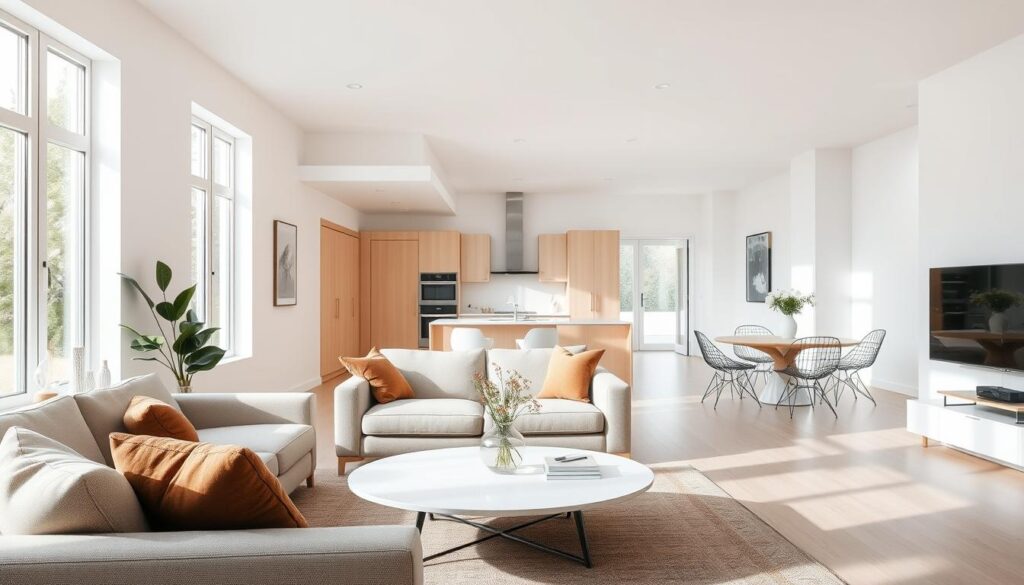
7. Iconic Design Styles Throughout History
As we explore design history, we find iconic styles that still shape our homes today. These styles show the culture, society, and economy of their times. Knowing these styles helps us see how interior design has evolved and guides us in decorating our homes.
Overview of Modernism and Its Features
Modernism started in the early 20th century. It focuses on function, simplicity, and clean lines. It rejects fancy details for a minimalist look, using new materials and tech.
Key Features of Modernism:
- Clean lines and minimal ornamentation
- Emphasis on functionality
- Incorporation of new materials and technologies
- Open floor plans
- Large windows to let in natural light
Modernism has shaped interior design, pushing for simplicity and function. As designer Dieter Rams once said, “Less but better” , showing Modernism’s design philosophy.
Elements of Mid-Century Design
Mid-Century Modern design, from the 1940s to the 1970s, is unique. It uses organic and geometric shapes, mixing materials like wood, metal, and glass. It blends well with nature, with big windows and outdoor areas.
Elements of Mid-Century Design:
- Organic and geometric forms
- Mix of materials like wood, metal, and glass
- Integration with nature through large windows and outdoor spaces
- Iconic furniture pieces, such as the Eames Lounge Chair
- Bold color schemes and patterns
“The goal of design is to create an environment that is both functional and beautiful, a space that reflects the personality of its inhabitants.” –
Modernism and Mid-Century design still inspire today’s interior design. They offer timeless and stylish ideas for our homes. By learning about these styles, we can make our homes both beautiful and practical.
8. Personalizing Your Space with Art
Art can change a room, making it show your style and taste. It’s key to making your house feel like home.
Art is more than just wall decor. It’s about picking pieces that speak to you and make your space better. “The right art can elevate a room, making it feel more personalized and inviting,” say interior design experts.
Choosing the Right Art Pieces
Think about the style and era that you like. Whether it’s modern abstract or classic landscapes, choose art that shows your personality.
- Match the art’s color to the room’s color scheme.
- Make sure the art fits with the furniture and room size.
- Choose pieces that mean something to you or tell a story.
Arranging Art for Maximum Impact
After picking your art, arrange it to make a big impact. Here are some tips:
- Use a big piece or a group of smaller ones as a room focal point.
- Try different setups until you find one that looks good and feels right.
- Hang art so the center is at eye level.
By choosing and arranging art well, you add depth and personality to your home. It becomes truly yours.
As we keep exploring home styling tips, remember art is a changing part of your home. It lets your home stay fresh and inspiring.
9. Functional Furniture for Small Spaces
Small spaces need furniture that uses every inch wisely. It’s key to pick pieces that fit well and do more than one thing. This makes the home more functional.
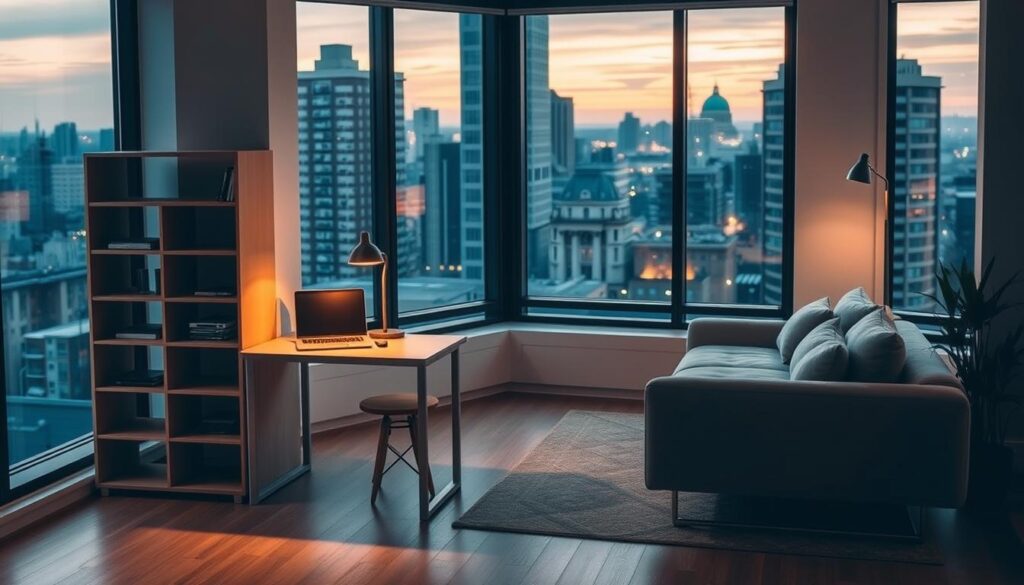
Space-Saving Solutions
Decorating small spaces means choosing furniture that saves space but doesn’t lose style or comfort. Wall-mounted shelves and foldable tables are great for saving space in small homes.
Using furniture with legs instead of big bases helps make rooms feel bigger. This, along with minimalist design principles, makes small spaces feel more open and larger.
Multi-Functional Pieces to Consider
Multi-functional furniture is key for decorating small spaces well. Items like storage ottomans and sofa beds are super useful. They offer a place to sit and store things, or to sleep.
- Murphy beds that fold up against the wall, giving room during the day.
- Nesting tables that stack together to save space when not in use.
- Drop-leaf tables that expand when needed and fold back when not.
By using these home and interior design ideas and interior decorating tips, you can make a small home functional, comfy, and stylish.
10. Outdoor Spaces: Extending Your Home
By taking our living areas outside, we connect with nature and make our homes better. This trend lets us enjoy fresh air and the beauty around us. We can turn our outdoor spaces into places for relaxation, fun, and play.
Designing an Inviting Patio
A cozy patio is key to a great outdoor area. Think about the layout and furniture. Comfortable seating and shade are must-haves. You can use umbrellas, pergolas, or gazebos for shade, based on your style and space.
Lighting is also important. Solar-powered lights or string lights create a nice feel at night. Adding outdoor heaters or fire pits makes your patio useable in cooler weather.
- Choose durable, weather-resistant materials for furniture and decor.
- Consider the scale of your furniture relative to the size of your patio.
- Incorporate plants and greenery to enhance the natural ambiance.
Incorporating Plants and Greenery
Adding plants and greenery makes your outdoor space look better and healthier. They can offer shade, cut down on noise, and attract good wildlife like birds and butterflies.
| Plant Type | Benefits | Care Requirements |
|---|---|---|
| Flowering Plants | Add color and vibrancy | Regular watering, fertilizing |
| Succulents | Drought-resistant, low maintenance | Infrequent watering, well-draining soil |
| Trees | Provide shade, habitat for wildlife | Regular watering, pruning |
Choosing the right plants for your outdoor space makes it welcoming and reflects your style. It also matches your home’s look.
11. Smart Home Technology in Interior Design
Smart home technology is changing how we live in our homes. It makes our homes more convenient, efficient, and fun.
Smart home tech includes many devices and systems. They can be controlled from afar or work on their own. These systems change how we use our homes, from lights and temperature to security and entertainment.
Benefits of Integrating Technology
Adding smart home tech to our homes has many benefits. Some key ones are:
- Increased Convenience: We can control our homes from anywhere with smart devices.
- Energy Efficiency: Smart devices help save energy, making our homes greener.
- Enhanced Security: Smart systems keep an eye on our homes and alert us when needed.
- Personalization: Smart tech lets us make our homes fit our style and needs.
Innovative Devices for Every Room
There are many cool devices to make our homes better. Some examples are:
- Smart Lighting: LED bulbs that we can control with apps or voice assistants.
- Smart Thermostats: Devices that learn our temperature likes and adjust them.
- Home Security Cameras: Cameras that watch our homes and send alerts.
- Smart Speakers: Voice assistants that control other smart devices and play music.
As we use more smart home tech, it’s key to think about how it fits with our design. Choosing devices that match our style makes our homes look good and work well.
When picking smart home devices, think about how they work, look, and fit with other tech. This way, we can have a modern, useful, and stylish home that improves our life.
12. Seasonal Decor: Refreshing Your Space
Incorporating seasonal decor is a smart way to keep your home lively. It helps you stay on top of interior design trends. This way, your home always looks current and welcoming.
Ideas for Year-Round Themes
For a theme that lasts all year, choose timeless pieces. Then, add seasonal touches to keep things fresh. For example, a neutral background can be updated with winter throws or summer flowers.
Transitioning Decor Between Seasons
Switching up your decor for each season is easy. Keep your furniture the same and swap out accessories like pillows and rugs. This method keeps your space looking new without a big change. It’s a smart way to keep your home stylish and up-to-date.

